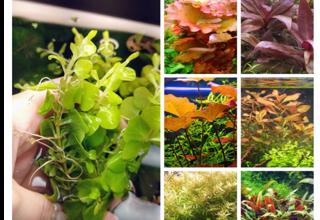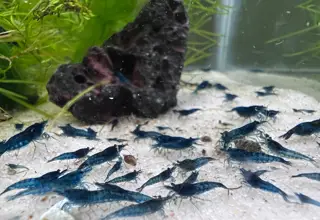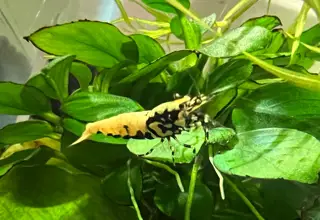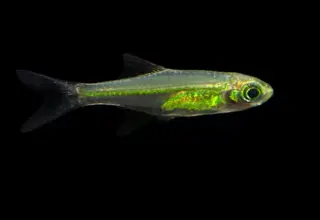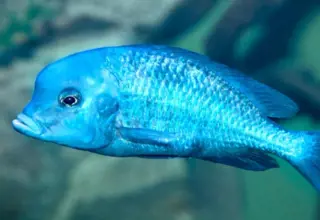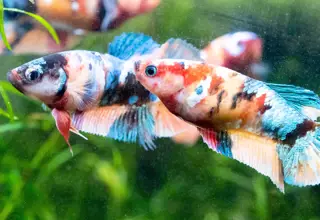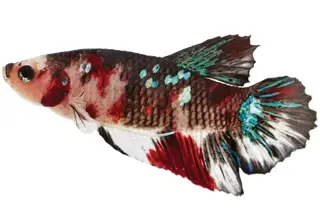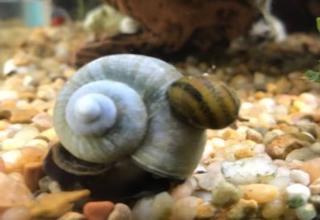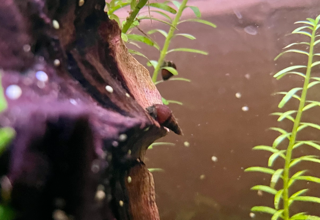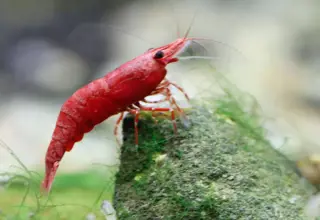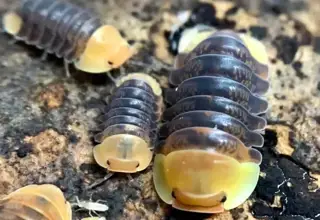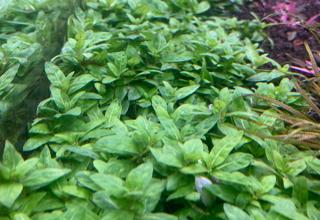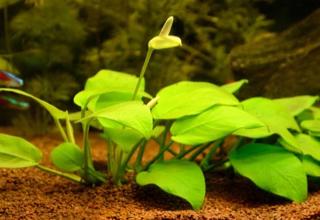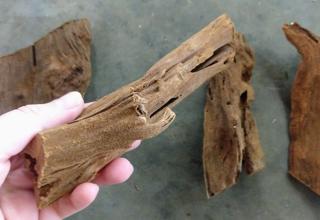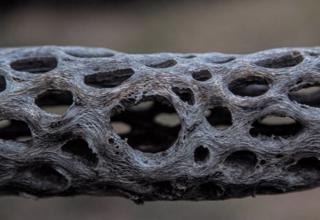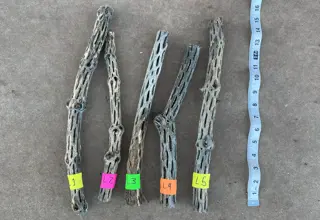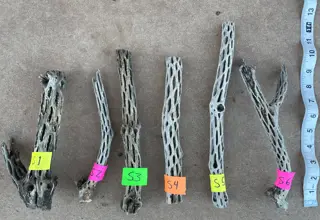Green Phantom Pleco: Care, Size, Appearance & More
Posted by on 02/23/2023
We use affiliate links and may receive a small commission on purchases.
Suckermouth catfish, often abbreviated as "plecos", are some of the most commonly seen fish in the freshwater aquarium hobby. Their popularity is for good reason, they're easy to care for and showcase unique and interesting color patterns.
One such species is known as the Green Phantom Pleco, and its eye-catching coloration makes it a favorite amongst hobbyists. If you’re considering the species as your next fish, you’ll want to be well-versed in its care requirements. In this post, we’re going to cover it all. We’ll discuss water parameters, lifespan, diet, and much more.
Table of Contents
Species Summary
The Green Phantom Pleco (scientific name: Hemiancistrus subviridis), is a species that hails from the Rio Orinoco , one of the largest rivers in South America. The river, which spans a large portion of Venezuela and drains into Colombia, plays host to a diverse group of wildlife, including giant otters, boto, and thousands of fish, including the popular Cardinal Tetra .
Hobbyists unfamiliar with plecos will appreciate their L-classification system. This system, created in the 1980s by the German magazine, DATZ , provides hobbyists with an additional way of naming species that haven't received a scientific designation.
Interestingly, the Green Phantom Pleco shares a common L number with another similar-looking species, Baryancistrus demantoides. The species closely resemble each other and were once thought to be the same species. Baryancistrus demantoides received its formal classification only as recently as 2005.

Appearance
Take a glance at a Green Phantom Pleco, and it's easy to understand why the fish is so popular. The Green Phantom Pleco sports a lemon-lime skin tone, with brightly colored yellow dots appearing on the front half of the fish's body.
The Green Phantom has two rows of teeth, which similar to other Plecos, are used for grazing on wood, an essential source of fiber for the Green Phantom's diet.
A large Dorsal fin plays an important role in keeping the fish stabilized against the fast-moving currents of its native habitat. While adults keep their Dorsal fin open at all times, juveniles may occasionally fold this fin to minimize resistance against water turbulence.
Round black eyes sit at the top of the fish, which the species uses to monitor the amount of light that enters the eye during the day. Both males and females have smooth heads without bristles.
Green Phantom Pleco vs Watermelon Green Phantom Pleco
Hobbyists interested in owning a Plecostomus fish with green coloration may confuse the Green Phantom with a similar-looking species, the Watermelon Green Phantom (scientific name: Panaque nigrolineatus laurafabianae). This species, L-classified as L-330, shares the same native habitat as the Green Phantom but is significantly larger.
Watermelon Green Phantom Plecos have a much darker coloration compared to the Green Phantoms and can reach a max length of 20 inches in size.
L-200 Hemiancistrus subviridis vs L-200 Baryancistrus demantoides
Baryancistrus and Hemiancistrus are two species that share the same L-classification number and look similar, but the key distinguishing feature between them is that Baryancistrus has a skin fold that connects its dorsal fin to the adipose fin. Hemiancistrus subviridis has these two fins separated.

Size
The Green Phantom Pleco is a relatively small fish, with adults reaching about 5 inches in length.
Their small size opens up a lot of opportunities for keeping these fish in smaller aquariums. Providing these fish with a well-balanced diet and a pristine environment will allow them to grow to their full adult size.
Green Phantom Pleco Care
In the wild, the Green Phantom Pleco shares an environment with thousands of other fish. While it may seem difficult to recreate the Rio Orinoco at home, with the proper knowledge, you can create a similar environment in which your Green Phantom will thrive.

Lifespan
The Green Phantom Pleco can live for about 5-8 years in captivity, and in rare cases can live for up to 10 years.
Diet, a stress-free environment, and pristine water conditions are the biggest contributors that allow your Green Phantom Pleco to live a long and healthy life.
Tank Size
Since the Green Phantom is considered to be a small pleco, you'll only need an aquarium that's at least 30 gallons in size to house this species.
Their small size makes them a great choice for a nano tank, but don't be afraid to go bigger. Larger aquariums tend to do a better job at keeping parameters more stable, and they also allow for a variety of different tank mate additions.
Water Conditions
The Green Phantom Pleco hails from a tropical climate, where the fish lives in fast-moving, pH-neutral, warm waters.
Aim for the following if you plan on housing the species.
Temperature Range: 73°F-82°F
pH: 6.5-7.6
KH: 3-10 dKH
Before purchasing, you'll want to ensure that your tank is fully cycled . A testing kit can be used to monitor pH, ammonia, nitrite, and nitrate. API's Freshwater Master Test Kit is a great option.
Tank Setup
A carefully planned aquarium is essential when housing a Green Phantom Pleco. The rivers of the Rio Orinoco are lush with vegetation. Popular aquatic plants such as Cabomba, Alternanthera, Bacopa, and Salvinia can be found in the clear-watered wetlands which play home to the species.
Different types of driftwood, such as Mopani and Cholla can be added to give your tank a more natural look. Plus, it is an essential food that provides Green Phantoms dietary benefits.
Beige sand or gravel substrate will work well in a Pleco aquarium, and stones such as Texas Holey Rock, Dragon Stones, or Seiryu stones can be used to create captivating aquascapes.
An adjustable powerhead can be used to re-create different flow rates, but as long as there is a sufficient amount of surface agitation, the Green Phantom Pleco can adapt to low and high flow rate conditions.

Common Diseases
Green Phantom Plecos are susceptible to many of the same diseases that affect most freshwater fish. It's important to always quarantine new fish when possible so that you do not unintentionally introduce new diseases or parasites into your display tank.
Luckily, some of the more common diseases that affect freshwater fish are easily curable, but you'll want to know what to do in case you have to deal with an outbreak.
Ich
One of the most common diseases, Ich (scientific name: Ichthyophthirius multifiliis) is a parasite capable of causing fatal damage to your tank inhabitants. If left untreated, it will attack and kill livestock, and then reproduce itself via single cells, called trophants.
Symptoms are usually visual. Small white dots (the trophants) will appear over the body of affected fish, which can also demonstrate a lack of appetite, lethargy, and increased rates of respiration.
Occasionally, fish affected by the disease will dart into objects, a process called "flashing".
Treatment is relatively straightforward. Many hobbyists have been able to eradicate the parasite by raising their internal aquarium temperature to 86°F. After about 5 days, the parasite should begin to die off and symptoms should improve. If increasing the temperature doesn't cure the disease, consider treatment with a product like API's Super Ich Cure .
Epistylis
Often confused with Ich, Epistylis is a single-celled protozoan, which can display similar symptoms to Ich. Affected fish will lose their appetite, and may appear as translucent patches, powdery dust, or raised-salt-like granules that appear on the fish's body. It's also possible for Epistylis to coexist with Ich, and the disease can be fatal.
While poor water quality is often attributed to the outbreak of this disease, treatment involves reducing tank temperatures by 5-10°F., and dosing Super Ich Cure and Maracyn 2 .
If successful, the disease should start to clear up after 1-2 rounds of treatment.
Food & Diet
Green Phantom Plecos are omnivorous fish and should be fed a diet consisting of nutrient-rich algae wafers and blanched foods such as peas, lettuce, and zucchini 1-2 times a day.
As a treat, you can supplement their diet with bloodworms and earthworms.
Behavior and Temperament
Green Phantom Plecos are peaceful fish, and spend most of their time grazing on algae and lounging along the substrate. They love to hang out in small caves, including artificial ones .
While they may occasionally go for a short swim, these fish are incredibly laid back. The only exception is during feeding time, when they may be a bit overprotective of their meal.
Tank Mates
If you're setting up a brand new aquarium, you can introduce other species of plecos, such as the Queen Arabesque Pleco and the Green Dragon Bristlenose. Avoid adding a Green Phantom to a tank with existing plecos, as this can lead to territorial disputes.
Other tank mate options include:
Avoid aggressive fish, such as the Cuban Cichlid, Red Dragon Flowerhorn Cichlid or Electric Blue Jack Dempsey.
Breeding
Hobbyists looking to breed the Green Phantom will be pleased to know that the species has been successfully bred in captivity. It can be difficult to spot the differences between male and female species. Breeders will often purchase a small group of fish at once and wait for a pair up.
Breeders should have an established fry-raising tank that is fully cycled and filtered. Temperatures should be raised to about 77-78°F.
These fish are cave-spawners, so 1-2 artificial caves should be provided.
You can introduce the mating pair, and observe their behavior. Typically they'll stay near the artificial caves before spawning. If they spawn, they'll lay about 40 eggs at a time, which typically hatch in 3-4 days.
The difficult part is raising the fry. You'll need to feed them infusoria or powdered spirulina for 3-5 days, after which you can transition to small bits of baby brine shrimp. You'll also need to perform 20% weekly water changes to maintain pristine water conditions. If done correctly, you can transition the fry once again from baby brine shrimp to small flake food.
Maintain these feeding and water change schedules for 3-4 months, and you'll have successfully bred the Green Phantom Pleco.
Where To Purchase
Green Phantom Plecos can be purchased when available on our marketplace, and can also be found for sale on some of the larger online retailers.
Green Phantom Plecos aren't nearly as common as the Common Pleco, and their rarity often correlates to a higher price tag. Hobbyists can expect to pay between $50-$100 for a single Green Phantom Pleco.
In Conclusion
The Green Phantom Pleco is a great choice for hobbyists looking for a small and attractive plecostomus species. It's an easy-to-care-for, attractive fish that can coexist with many popular freshwater fish.
Now that you've learned all about this species, do you plan on adding one to your fish tank? We have a strong feeling it's a choice you won't regret. Let us know what you think by commenting below, and be sure to check out our marketplace and community forum where you can connect with other hobbyists.
